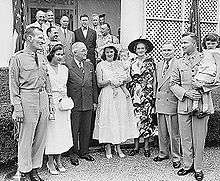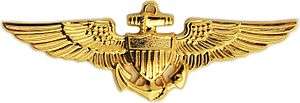Henry A. Commiskey Sr.
| Henry Alfred Commiskey Sr. | |
|---|---|
  Henry A. Commiskey Sr. Medal of Honor recipient | |
| Born |
January 10, 1927 Hattiesburg, Mississippi |
| Died |
August 15, 1971 (aged 44) Meridian, Mississippi |
| Place of burial | cremated, location of ashes Gulf of Mexico between Gulfport and Biloxi, MS at coordinates 30 degrees 05 minutes North, 88 degrees 35 minutes West, scattered on 24 August 1971 at 11:45 a.m. central time |
| Allegiance |
|
| Service/branch | United States Marine Corps |
| Years of service | 1944-1966 |
| Rank | Major |
| Unit |
1st Battalion 1st Marines Marine Attack Squadron 212 |
| Battles/wars |
World War II -Battle of Iwo Jima Korean War -Battle of Inchon |
| Awards |
Medal of Honor Purple Heart |
Major Henry Alfred Commiskey Sr. (January 10, 1927 – August 15, 1971) was a United States Marine who served during World War II at the Battle of Iwo Jima and in the Korean War in the Inchon landing. As a lieutenant, he was the first Marine to receive the Medal of Honor — the nation's highest decoration for valor — for extraordinary heroism in the Korean War, leading a charge up a hill and killing seven enemy soldiers in hand-to-hand combat.
Biography
Henry Commiskey was born on January 10, 1927, in Hattiesburg, Mississippi. He attended Sacred Heart School in Hattiesburg and worked as a brakeman on the Illinois Central Railroad before joining the Marine Corps on January 12, 1944, two days after his 17th birthday.[1]
Commiskey served in the enlisted ranks more than five years, including 21 months overseas.
He completed his recruit training in San Diego, California. He then served at Camp Pendleton; Hawaii; in the Pacific Theatre during World War II, and in Japan.
World War II
During World War II, he was wounded in action during the Iwo Jima campaign — for which received the Letter of Commendation for “exhibiting high qualities of leadership and courage in the face of a stubborn and fanatical enemy."
Commiskey also had been a drill instructor at the Marine Corps Recruit Depot Parris Island, South Carolina. He was serving there, with the rank of staff sergeant, when he was accepted for officer training and commissioned a second lieutenant on September 10, 1949. He completed training in June 1950, and taught in the tactics section at the Marine Corps Schools Quantico, Virginia, before going to Korea with the 1st Marines in August 1950.
Korean War - Medal of Honor action

The action for which 1stLt Commiskey received the Medal of Honor came a few days after the Inchon landing, in which he participated.
The action occurred on September 20, 1950 near Yongdungpo, Korea, on the outskirts of Seoul. Although Major Commiskey, then a second lieutenant, escaped harm then, he was wounded a week later, and again on December 8, 1950, after which he was returned to the U.S. for hospitalization.
Following hospitalization at the Naval Hospital in Pensacola, 1stLt Commiskey served at the Naval Air Rocket Test Station, Lake Denmark, Morris County, New Jersey.
He was promoted to first lieutenant in June, 1951.
On August 1, 1951, he was presented the nation's highest decoration for valor by President Harry S. Truman in a White House ceremony for his actions on September 20, 1950 near Yongdungpo, Korea, on the outskirts of Seoul.[2]
Aviator
In September 1951, he became a Student Naval Aviator at the Naval Air Station, Pensacola. He received his wings at Corpus Christi in June 1953, and later completed jet training at El Toro, California. He was promoted to captain in July 1953.
In April 1954, he returned to Korea as a pilot with Marine Attack Squadron 212, Marine Aircraft Group 12, 1st Marine Aircraft Wing.
1954-1966
He returned to the United States in September 1954, and at his own request was assigned line duty. He joined the 1st Marine Division in December 1954, and served consecutively as a company commander, Assistant S-3 of the 1st Service Regiment, and Division Reenlistment Officer. From September 1956 until July 1959, he served as Officer in Charge of the Marine Corps Recruiting Station, 6th Marine Corps Reserve and Recruitment District, Jackson, Mississippi. He was promoted to major in July 1959.
Major Commiskey completed the Junior Course at the Marine Corps Schools, Quantico, Virginia, in June 1960, then served as an instructor, student company commander and Executive Officer, The Basic School, Quantico. Prior to his retirement from active duty in August 1966, he served as a recruiter.
Commiskey died on August 15, 1971, in Meridian, Mississippi and was cremated. His ashes were spread over the Pacific ocean by his son in honor of his service.[3]
Awards and honors
Medal of Honor citation
The President of the United States takes pleasure in presenting the MEDAL OF HONOR to
FIRST LIEUTENANT HENRY A. COMMISKEY
UNITED STATES MARINE CORPS
for service as set forth in the following CITATION:
For conspicuous gallantry and intrepidity at the risk of his life above and beyond the call of duty while serving as a Platoon Leader in Company C, First Battalion, First Marines, First Marine Division (Reinforced), in action against enemy aggressor forces near Yongdungp'o, Korea, on 20 September 1950. Directed to attack hostile forces well dug in on Hill 85, First Lieutenant Commiskey, then Second Lieutenant, spearheaded the assault, charging up the steep slopes on the run. Coolly disregarding the heavy enemy machine-gun and small-arms fire, he plunged on well forward of the rest of his platoon and was the first man to reach the crest of the objective. Armed only with a pistol, he jumped into a hostile machine-gun emplacement occupied by five enemy troops and quickly disposed of four of the soldiers with his automatic pistol. Grappling with the fifth, First Lieutenant Commiskey knocked him to the ground and held him until he could obtain a weapon from another member of his platoon and kill the last of the enemy gun crew. Continuing his bold assault, he moved to the next emplacement, killed two or more of the enemy and then led his platoon toward the rear nose of the hill to rout the remainder of the enemy. His valiant leadership and courageous fighting spirit served to inspire the men of his company to heroic endeavor in seizing the objective and reflect the highest credit upon First Lieutenant Commiskey and the United States Naval Service.[4]
/S/ HARRY S. TRUMAN
Military decorations

Maj Commiskey was awarded the following decorations:
 | |||||||||||
| Naval Aviator Badge | ||||||||||||
| 1st Row | Medal of Honor | Purple Heart with two gold stars | Letter of Commendation Ribbon with Medal Pendant | Presidential Unit Citation with two bronze stars | ||||||||
|---|---|---|---|---|---|---|---|---|---|---|---|---|
| 2nd Row | Marine Corps Good Conduct Medal | Asiatic-Pacific Campaign Medal with one bronze star | World War II Victory Medal | Navy Occupation Service Medal with Asia clasp | ||||||||
| 3rd Row | National Defense Service Medal with one bronze star | Korean Service Medal with three bronze stars | United Nations Service Medal | Korean Presidential Unit Citation | ||||||||
Namesake
On June 5, 2004, a United States Postal Service facility in Hattiesburg, Mississippi was officially named the "Major Henry A. Commiskey Sr., Post Office Building".[5]
See also
Notes
- ↑ "Major Henry Alfred Commiskey Sr., USMC". Who's Who in Marine Corps History. History Division, United States Marine Corps. Retrieved 2007-10-14.
- ↑ "One for the Marines". TIME Magazine. August 13, 1951. Retrieved 2007-10-14.
- ↑ "Henry A. Commiskey Sr.". Claim to Fame: Medal of Honor recipients. Find a Grave. Retrieved 2007-11-11.
- ↑ "1stLt Henry A. Commiskey, Medal of Honor, 1950, 1/1/1, Korea (Medal of Honor citation)". Marines Awarded the Medal of Honor. History Division, United States Marine Corps. Archived from the original on 2007-02-20. Retrieved 2007-06-11.
- ↑ President George W. Bush signed H.R. 2438 into law on June 5, 2004, naming the Post Office in Hattiesburg, Mississippi.
Office of the Press Secretary (June 25, 2004). "Statement on White House Resolutions (June 5, 2004)". The White House. Retrieved 2007-10-14.
References
 This article incorporates public domain material from websites or documents of the United States Marine Corps.
This article incorporates public domain material from websites or documents of the United States Marine Corps.
- "Henry A. Commiskey Sr.". Claim to Fame: Medal of Honor recipients. Find a Grave. Retrieved 2007-11-11.
- "Major Henry Alfred Commiskey Sr., USMC". Who's Who in Marine Corps History. History Division, United States Marine Corps. Retrieved 2007-10-14.
- "1stLt Henry A. Commiskey, Medal of Honor, 1950, 1/1/1, Korea (Medal of Honor citation)". Marines Awarded the Medal of Honor. History Division, United States Marine Corps. Archived from the original on 2007-02-20. Retrieved 2007-06-11.
- Hoyt, Edwin P., On To The Yalu, (1984), ISBN 0-8128-2977-8